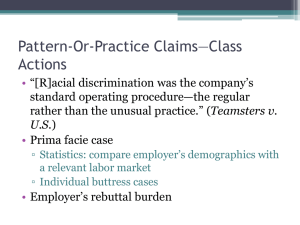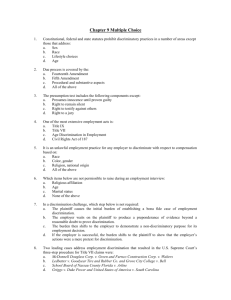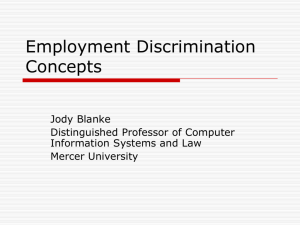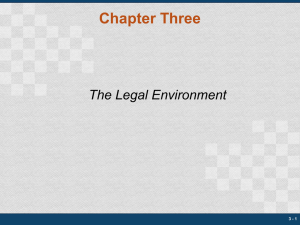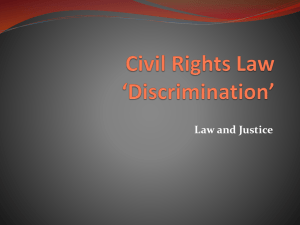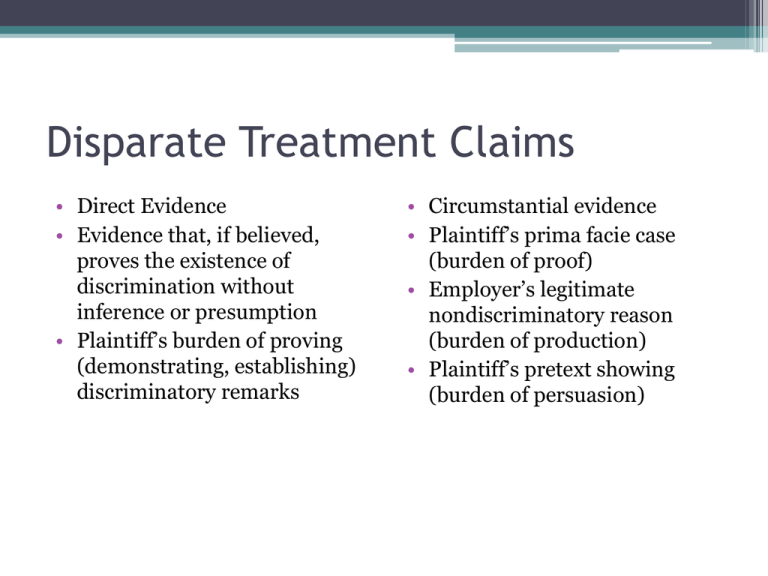
Disparate Treatment Claims
• Direct Evidence
• Evidence that, if believed,
proves the existence of
discrimination without
inference or presumption
• Plaintiff’s burden of proving
(demonstrating, establishing)
discriminatory remarks
• Circumstantial evidence
• Plaintiff’s prima facie case
(burden of proof)
• Employer’s legitimate
nondiscriminatory reason
(burden of production)
• Plaintiff’s pretext showing
(burden of persuasion)
Disparate Treatment Claims
• Title VII Mixed-Motives
Analysis
• Sec. 703(m)
• Unlawful employment practice:
race, color, religion, sex, or
national origin was motivating
factor for employment practice:
employer is liable
• Employer proof that same
decision would have been made
in the absence of the
impermissible motivating
factor: limited relief
• After-acquired evidence
• Employer takes adverse action
based solely on discriminatory
reason
• Employer proves that, after
discharge, information came to
light of employee wrongdoing
that would have led to
termination on legitimate
grounds had the employer
known about it
• Employer is liable; backpay
limited to period covering the
date of unlawful discharge to the
date of discovery of new
information; no reinstatement
or front pay
Disparate Treatment—Systemic
Discrimination
• Pattern-or-practice claims
• Statistical evidence and the plaintiff’s prima
facie case (burden of proof): discrimination was
the company’s standard operating procedure—
the regular rather than the unusual practice
▫ Compare racial composition of workforce and
racial composition of relevant labor market
▫ Individual cases bolstering the statistics, if any
• Employer’s rebuttal (refutation of statistics, etc.)
Disparate Treatment—Retaliation
• Title VII Sec. 704(a)
• Opposition and participation clauses
• Standard: a reasonable employee would have
found the challenged employer action materially
adverse, which means that it might well have
dissuaded a reasonable worker from making or
supporting a charge of discrimination
• No mixed-motive retaliation claims under Title
VII
Disparate Treatment—Harassment
• Harassment claims: race, color, religion, sex,
national origin, age, disability
• Sexual harassment quid pro quo/tangible job
detriment cases
• Sexual harassment hostile environment cases
▫ To be actionable the harassment must be sufficiently
severe or pervasive to alter the victim’s employment
and create an abusive working environment
▫ Conduct must create an objectively hostile
environment and the victim must subjectively perceive
the environment to be abusive
Disparate Treatment—Harassment
• Supervisory tangible job detriment harassment:
employer is strictly liable
• Supervisory harassment, hostile environment
cases: employer is vicariously liable subject to a
two-pronged affirmative defense to liability or
damages
• Coworker harassment: standard of employer
liability is negligence (employer knew or should
have known)
Disparate Treatment—Sex
Discrimination
•
•
•
•
“Because of sex” prohibition
Pay discrimination
Pregnancy: Title VII Sec. 701(j)
Sexual orientation and gender identity
discrimination claims
• The BFOQ defense (Title VII Sec. 703(e))
• Grooming and appearance standards
Disparate Treatment—Religion
• Title VII Sec. 701(j) (religious observance and
practice as well as belief)
• Employer reasonable accommodation obligation
subject to an undue hardship defense
Disparate Treatment—National Origin
• National origin: the country where a person was
born or the country from which his or her
ancestors came
• Accent discrimination
• English-only rules
Disparate Impact Cases—Title VII
• Title VII Sec. 703(k)
• Prima facie case (plaintiff’s burden of proof)
▫ Facially neutral practice or policy causing
disparate impact on a protected group
• Job-related/consistent with business necessity
(defendant’s burden of proof)
• Alternative practices with less discriminatory
impact that serve the employer’s needs?
(plaintiff’s burden of proof)
Disability Discrimination
• The ADA and the ADAAA
• “Disability”: (1) physical or mental impairment
that substantially limits one or more major life
activities of such individual, or (2) record of such
an impairment, or (3) being regarded as having
such an impairment
Age Discrimination
• Direct evidence?
• Plaintiff’s prima case showing in circumstantial
evidence cases; employer’s LNR; plaintiff’s pretext
showing
• No ADEA mixed-motive cases
• Disparate impact cases and the reasonable factor
other than age provision
▫ Plaintiff’s prima facie case
▫ Was the employer’s decision reasonable? (employer
bears burden of production and persuasion)

